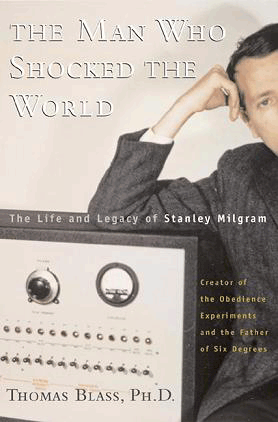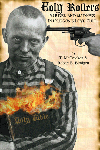Creffield, Obedience to Authority and Stanley Milgram
 “When Franz
Edmund Creffield placed his hands on his followers heads they were absolutely
in his power and did anything he told them,” Burgess Starr, an in-law of Creffield’s,
said. “Had he told them to jump in the river they would not have hesitated a
moment, but plunged in.” And when he ordered them to, they did more than jump
in a river. When he ordered them to burn cats and dogs and to do worse, they
burned cats and dogs and did worse.
“When Franz
Edmund Creffield placed his hands on his followers heads they were absolutely
in his power and did anything he told them,” Burgess Starr, an in-law of Creffield’s,
said. “Had he told them to jump in the river they would not have hesitated a
moment, but plunged in.” And when he ordered them to, they did more than jump
in a river. When he ordered them to burn cats and dogs and to do worse, they
burned cats and dogs and did worse.
“They must have
been social deviants,” a member of the audience once said when I was doing a
reading from Holy Rollers. “Who else
but Nazis and social deviants would so blindly follow heinous orders?” Is this
true? Would only a social deviant obey an immoral order?
It is true that
many Nazis during their trials for war crimes said, “I was only following
orders.” If every social deviant, sadist, and all round badnick in Germany
joined the Nazi party in the 1930s and “just followed orders,” would that
account for all the crimes against humanity that were committed during World
War II? Unlikely. Millions of people were murdered. Far too many for there not
to have been ordinary citizens--people who before the war were kind, descent,
caring people, people like you and me--involved in committing some of the
atrocities.
And how do you
get ordinary citizens to perform such deeds? Apparently, if you’re an authority
figure, all you have to do is order them to do so, and they will do it. Such
were the findings of Dr. Stanley Milgram.
Milgram did an
experiment where he had an authority figure--someone in a white coat--tell two
volunteers that they were participating in a psychological study on the effect
punishment had on learning. The person in white told the volunteers that in the
experiment one of them would be the "teacher" and one of them would
be the "learner." Which role they assumed was to be determined by
lot.
Those whose lots
it was to be the teachers must have initially felt some relief as the other
volunteers, the learners, were strapped into chairs and had electrodes hooked
to their bodies while they, the teachers, were seated in front of a generator
with switches that went from 15 volts to 450 volts. Two switches were simply
labeled "XXX". The person in white explained that the volunteer who
was the teacher was to read a list of two word pairs and ask the volunteer who
was the learner to read them back. If the learner answered correctly, the
teacher was to move on to the next word. However, if the learner answered incorrectly,
the teacher was supposed to zap the learner with 15 volts. Err again, and the
teacher was to up the voltage and zap the inept learner with 30 volts. Err
again. 45 volts, and so on until . . . ? Well, that was the question. How far
would the teachers crank up the voltage before saying: “No, I won’t continue?” Milgram
really wasn’t studying learning, but how far ordinary people go when following
the orders of a person in authority.
Many of the
teachers obviously felt discomfort zapping helpless moaning, screaming, and
twitching victims, but zap away, they did. Even when one of the learners
complained of having heart problems and pleaded not to be shocked, the teachers
zapped them. They weren’t responsible. Those
in authority were. They were just following orders. The ends justify the means. None of the teachers stopped zapping erring learners before reaching 300
volts. None! Two-thirds of the teachers zapped to the max, 450 volts.
Fortunately,
Milgram’s “learners” weren’t really volunteers and they weren’t hooked up to
electrodes. They were actors and the experiment was rigged to that they always
drew the lots to be the zapped learners.
And Milgram’s
volunteer teachers? Were they Nazis? No. They were Americans who, in Milgram’s
words, were “ordinary people drawn from the working, managerial, and
professional classes.” Milgram, you see, had conducted his experiments not in
Nazi Germany, but at Yale in 1961 and 1962.
"The
results, as seen and felt in the laboratory, are,” Milgram wrote, “disturbing.
They raise the possibility that human nature, or--more specifically--the kind
of character produced in American society, cannot be counted on to insulate the
citizens from brutality and inhumane treatment at the direction of malevolent
authority."
Alas, it wasn’t
just American society that produced these disturbing results. When others around
the world replicated Milgram’s experiments--which today would be considered
unethical--they had similar statistical results.
So who but a
social deviant would obey an order to burn cats and dogs and to do worse? Maybe
as many as 65% of humanity would. Maybe I would. Maybe you would. Especially if
we were in Creffield’s followers place. Long before he asked his followers to
violate the commandments, Creffield had them convinced that he was God’s Elect,
the Second Savior, their Lord. That gave him an appearance of authority that a
white coat can’t begin to equal.
***
To read more on
Stanley Milgram’s study read his book, Obedience
to Authority: An Experimental View, published by Harper Collins in 1974.
For more information on Stanley Milgram go to www.stanleymilgram, a site maintained by Thomas Blass, PhD., a professor of psychology at the University of Maryland and author of, The Man Who Shocked the World, an autobiography of Milgram.
Information about Brainwashing & Thought Reform
Lifton's eight 'psychological themes' that can be found in totalist groups like the Holy Rollers:
***
Stanley Milgram's Obedience to Authority
***
Think You Can't be Lured into a Cult? Think Again.
The Oregon State Insane Asylum in 1907
***
Relevant Newspaper Articles:
October to December 1903: Holy Rollers Burn Furniture & Pets
April to June 1904: Holy Rollers are Committed to the Asylum
Chapters from
Holy Rollers: Murder & Madness in Oregon's Love Cult
Part 1: The Seduction
Chapter 1: Trust Me, Brothers And Sisters
(Life Before Creffield [B.C.])
Chapter 2: God, Save Us From Compromising Preachers
(Creffield's Preachings)
Chapter 3: The Flock
(Profiles of the Holy Rollers Were)
Chapter 4: The Holy Rollers
(Things Start to Get Wild on on Kiger Island)
Chapter 5: Housecleaning
(There's a Sacrificial Bonfire)
Chapter 6: Community Concerns
(Officers Visit)
Chapter 7: Esther, The Chosen One
(Creffield Plans to Marry 16-Year- Old)
Chapter 8: Tar and Feathers
(The Men of Corvallis Act)
Chapter 9: Sane People Don’t Go Bareheaded
(Holy Rollers are Committed to the Asylum)
Chapter 10: More Beast Than Man
( Creffield is Arrested)
Chapter 11: God Will Plead Creffield's Case
(Creffield in Court)
Chapter 12: Scandal
(Shocking Testimony at the Trial)
Chapter 13: Calm Before the Storm
(The Holy Rollers Resume their Lives)
Chapter 14: Giving Up The Ghost
(Men are Gunning for Creffield)
Part Two: The People V. Creffield
Chapter 16: The Widow Creffield
Chapter 19: An Inherited Streak of Insanity
Part Three: The Madness
Chapter 23: Seeking Reconciliation
Chapter 24: Another Holy Roller Page One Murder
Chapter 25: What Can Papa Do For You?
Chapter 26: Human Life is Too Cheap In This Community
Chapter 30: The Final Chapter
(What Happened to Everyone Afterwards)
The Epilogue
(Heaven's Gate)
